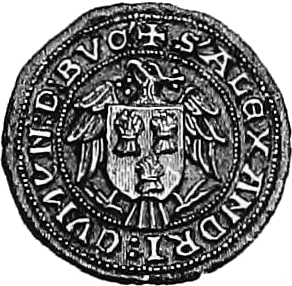
The title Duke of Abercorn is a title in the Peerage of Ireland. It was created in 1868 and bestowed upon James Hamilton, 2nd Marquess of Abercorn. Although the Dukedom is in the Peerage of Ireland, it refers to Abercorn, West Lothian, and the Duke also bears four titles in Peerage of Scotland and two in the Peerage of Great Britain, and is one of only three peers who have titles in those three peerages. The Duke of Abercorn also claims the French title of Duke of Châtellerault, created in 1548.

Earl of Elgin is a title in the Peerage of Scotland, created in 1633 for Thomas Bruce, 3rd Lord Kinloss. He was later created Baron Bruce, of Whorlton in the County of York, in the Peerage of England on 30 July 1641. The Earl of Elgin is the hereditary Clan Chief of Clan Bruce.

Lord Lovat is a title of the rank Lord of Parliament in the Peerage of Scotland. It was created in 1458 for Hugh Fraser by summoning him to the Scottish Parliament as Lord Fraser of Lovat, although the holder is referred to simply as Lord Lovat.

This page is concerned with the holders of the forfeit title Earl of Douglas and the preceding feudal barons of Douglas, South Lanarkshire. The title was created in the Peerage of Scotland in 1358 for William Douglas, 1st Earl of Douglas, son of Sir Archibald Douglas, Guardian of Scotland. The Earldom was forfeited by James Douglas, 9th Earl of Douglas, in 1455.
James Johnstone, 1st Earl of Hartfell was a Scottish peer and royalist.
The Frasers of Inverallochy descend from Simon Fraser, 6th Lord Lovat, and are one branch of the Clan Fraser of Lovat, who hail from Inverallochy. Simon was Sheriff of Inverness, and married twice. The Frasers of Lovat descend from this first marriage, while the Frasers of Inverallochy descend from a second marriage, through a son, Simon Fraser of Inverallochy. This Simon Fraser, 1st of Inverallochy, had a great-grandson, Charles Fraser, 6th of Inverallochy, who was created Lord Fraser of Muchall by James Francis Edward Stuart, known to Jacobites as King James VIII of Scotland, in the Jacobite Peerage of Scotland.

David de Lindsay, Lord of Barnweill and Byres, was a Scottish knight and crusader. A minor baronial lord, he was the son of David de Lindsay and held lands in East Lothian and South Ayrshire. He became Justiciar of Lothian under Alexander II of Scotland in 1241. This position had been held by his father earlier in the century.
Sir David de Lindsay, Lord of Crawford and Ercildum, known as "the elder" to distinguish him from his son, was an Anglo-Scottish baron of the 12th and 13th century.

William de Vesci or Vescy was a prominent 13th-century noble. He was a son of William de Vesci and his second wife Lady Agnes de Ferrers, daughter of William de Ferrers, 5th Earl of Derby, and his first wife Sibyl Marshal.

The Alexanders of Menstrie, also known as the House of Alexander, are a sept of Clan MacAlister of Scotland. The family is said to descend from Somerled, Lord of the Isles. The seat of the clan was at Menstrie Castle in Menstrie, Clackmannanshire. Descendants of the Alexanders of Menstrie have become prominent in Ireland, England and the United States.

Sir Alexander Lindsay, Lord of Barnweill, Byres and Crawford, also known as Alexander de Lindsay, was a Scottish noble.

Alexander Comyn, Sheriff of Aberdeen was a fourteenth-century Scottish nobleman. He was a younger son of Alexander Comyn, Earl of Buchan. The latter died in 1290, whereupon the earldom of Buchan was inherited by Alexander's elder brother, John.

Sir David Lindsay of Crawford was a Scottish noble.
Simon Fraser, 6th Lord Lovat (1570–1633) Scottish courtier and landowner.

Sir Eustace de Maxwell, Lord of Caerlaverock, was a prominent 14th-century Scottish noble.
Alexander Livingston, 3rd Earl of Callendar was a Scottish nobleman.
Walter de Lindsay, Lord of Lamberton and Molesworth, Fordington and Ulceby, Justiciar of Lothian, Sheriff of Berwick was a Scottish noble, who held lands in Scotland and England.

Sir Richard de Brus, Lord of Writtle was an English knight from Essex, commanding a Knight banneret for Edward I. He was a younger son of Robert de Brus, 5th Lord of Annandale and Isabella de Clare.
John Lindsay, Lord of Wauchope and Staplegorton, was a Scottish noble.

Henry de Pinkeney, Lord of Weden-Pinkeney, Fulmer and Datchet in England and Lord of Crawford in Scotland, was a 13th-century English noble.











